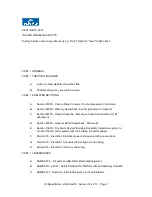
MK-00084 Rev. A
27
Q UI C KI E 7 R
IX. DEALER SERVICE AND ADJUSTMENT
Q. REAR AXLE
T
he most important adjustment on your Quickie wheelchair is the position of the rear axle. The center of gravi-
ty and wheel camber are determined by the axle adjustment.
1. Center of Gravity Adjustment
WARNING
The more you move your rear wheels forward, the more likely your chair will tip over backwards. Always make
adjustments in small increments, and check the stability of your chair with a spotter to prevent a tip-over. We rec-
ommend that you use anti-tip tubes until you adapt to the change and are sure you are not at risk to tip over.
Refer to additional Warnings in Section VI “Falls and Tip Over”.
NOTE– Changes to the center of gravity may affect the rear seat height (Section K), toe-in/toe-out of the
rear wheels (Section M-3) and the squareness of the casters (Section P). If you change your center of gravi-
ty position, re-adjust all of these settings if necessary.
NOTE– Adjusting your chair’s center of gravity will require re-adjusting the location of the wheel locks
(if provided). See Section R for instructions on adjusting the wheel locks.
NOTE– Range of adjustment can be limited by chair configuration and options selected.
Quickie Q7R Adjustable
You can adjust your center of gravity position by moving the two axle plate clamps (A) forward or rearward on
the seat tube (B). Moving the axle plate clamps forward shortens the wheelbase and lightens the front end, mak-
ing your chair more maneuverable. Moving the axle plates rearward makes the chair more stable and less likely
to tip over rearward.
To adjust the center of gravity location, remove both rear wheels. Loosen the 4 screws (C) (2 per side) that
secure the axle plates (A) to the seat tubes. Slide both axle clamps forward or rearward along the seat tube to
the desired position. Make sure both sides are adjusted symmetrically before tightening screws. Tighten screws to
62 in-lbs. (7 Nm).
Once the axle plate clamps are secured, attach the rear wheels. Occupy the chair and maneuver it with a spotter
to get a feel for the new adjustment.
Quickie Q7RS
NOTE–
Adjusting your chair’s center of gravity will require re-adjusting the location of the wheel
locks (if provided). See Section R for instructions on adjusting the wheel locks.
NOTE–
Active Camber Setup: Axle plate is welded per Center of Gravity requirement, per order.
NOTE–
Camber clamp to be centered on camber tube mount except when the Center of Gravity
is set at 0.5" or 4.0".
Y
ou can adjust the center of gravity position by moving the camber tube clamps (D) forward or rearward on
the camber tube mount. Moving the camber tube clamps forward shortens the wheelbase and lightens the front
end, making your chair more maneuverable. Moving the camber tube clamps rearward makes the chair more sta-
ble and less likely to tip over rearward.
To adjust the center of gravity location, remove both rear wheels. Remove the 4 screws, (E) (2 per side) that
secure the camber tube clamp to the camber tube mount (F). Slide both camber tube clamps forward or rear-
ward (keeping even on both sides) to the desired position insuring that holes in the camber tube clamp line up
with the camber tube mount. Make sure both sides are adjusted symmetrically before tightening screws. Tighten
screws to 62 in-lbs (7 Nm). Once the camber tube clamps are secured, attach the rear wheels. Occupy the chair
and maneuver it with a spotter to get a feel for the new adjustment
2. Wheel Camber
Wheel camber, shown as angular relationship (G), provides greater side-to-side stability due to the increased
width and angle of the wheelbase. It also allows for quicker turning and greater access to the top of the han-
drims.
Wheel camber is determined by pairs of interchangeable camber plugs which are available from your authorized
supplier in 0º, 3°, and 6º angles.
62
63
64
62
62
63
A
B
C
D
E
F
64
G


































